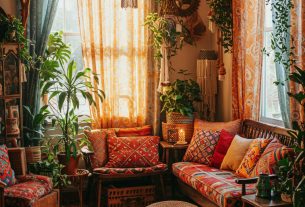As an interior designer, I often reflect on the profound impact that our work has on people’s lives. In today’s fast-paced world, where our environments increasingly influence our moods, productivity, and overall well-being, the role of interior design has never been more critical. In this article, I will explore the importance of interior design today, uncover emerging trends, and share my thoughts on how we can leverage design to create spaces that resonate with our personal and collective identities.
The Essence of Interior Design
Interior design is more than just arranging furniture or choosing color palettes; it’s a comprehensive approach to creating functional, aesthetically pleasing spaces that cater to the needs of individuals and communities. The essence of interior design lies in its ability to:
- Enhance functionality: A well-designed space improves how we interact with our environment.
- Influence emotions: Colors, textures, and layouts can evoke feelings and set the tone for a space.
- Reflect personality: Design allows individuals to express their unique identities through their surroundings.
- Support sustainability: Thoughtful design can minimize environmental impact and promote eco-friendly practices.
The Current State of Interior Design
In recent years, interior design has evolved dramatically, driven by shifts in societal values, technological advancements, and a deeper understanding of human psychology. Here are some key trends that define the current state of interior design:
1. Sustainability and Eco-Friendly Design
As climate change becomes an increasingly pressing issue, the demand for sustainable design practices is on the rise. Designers are focusing on:
- Using renewable materials: Bamboo, cork, and reclaimed wood are popular choices.
- Implementing energy-efficient solutions: LED lighting and smart home technologies help reduce energy consumption.
- Promoting indoor air quality: Incorporating plants and using low-VOC (volatile organic compounds) paints contribute to healthier living environments.
According to a report by the American Society of Interior Designers (ASID), 74% of designers believe that sustainability will be a key factor in future design projects.
2. Biophilic Design
Biophilic design emphasizes the connection between humans and nature. By incorporating natural elements into interiors, designers create spaces that enhance well-being and productivity. Key aspects of biophilic design include:
- Natural light: Maximizing sunlight through large windows or skylights.
- Indoor plants: Integrating greenery to improve air quality and aesthetics.
- Natural materials: Using stone, wood, and other organic materials to create a sense of harmony.
Research by the University of Technology Sydney indicates that biophilic design can reduce stress, increase creativity, and improve overall well-being.
3. Multi-Functional Spaces
With remote work and flexible living arrangements becoming more common, the need for multi-functional spaces has surged. Designers are now creating versatile environments that serve multiple purposes. For example:
- Home offices that double as guest rooms.
- Living rooms that incorporate workspace elements.
- Dining areas that can be reconfigured for entertaining or studying.
Case Studies: Successful Interior Design Projects
To illustrate the impact of these trends, let’s examine a few case studies of successful interior design projects:
Case Study 1: Green Building in New York City
A recent project in New York City involved the renovation of an office space into a green building that prioritizes sustainability. The design team implemented:
- Solar panels to harness renewable energy.
- Recycled materials for flooring and wall finishes.
- A green roof to promote biodiversity and provide insulation.
The result was a 50% reduction in energy costs and a healthier work environment, proving that sustainable practices can yield significant benefits.
Case Study 2: Biophilic Design in a Healthcare Facility
A healthcare facility in California adopted biophilic design principles to enhance patient experiences. Key features included:
- Healing gardens accessible from patient rooms.
- Large windows with views of nature.
- Art installations that reflect natural landscapes.
This approach led to a notable decrease in patient recovery times and reduced stress levels among staff and patients alike.
The Psychological Impact of Interior Design
Interior design profoundly influences our mental health and well-being. Understanding the psychological aspects of design can help us create environments that promote positivity and productivity. Here are a few insights:
Color Psychology
Colors play a crucial role in how we perceive and interact with spaces. Different colors evoke various emotions:
- Blue: Calming and promotes focus.
- Yellow: Energizing and uplifting.
- Green: Represents tranquility and nature.
By strategically using color, designers can create atmospheres that align with the intended purpose of a space.
Space Layout and Flow
The arrangement of furniture and the flow of a space can significantly impact how we feel. Open layouts encourage social interaction, while cozy nooks provide a sense of privacy and comfort. Effective space planning considers:
- Accessibility: Ensuring that spaces are easy to navigate.
- Comfort: Creating inviting areas that encourage relaxation.
- Functionality: Designing spaces that serve their intended purpose efficiently.
Emerging Technologies in Interior Design
Technology is reshaping the interior design landscape, providing new tools and opportunities for designers. Here are some noteworthy advancements:
Virtual Reality (VR) and Augmented Reality (AR)
VR and AR are revolutionizing how designers present their ideas to clients. These technologies allow clients to experience spaces before they are built, leading to more informed decisions. For example:
- Virtual walkthroughs enable clients to visualize different design options.
- Augmented reality apps allow users to see how furniture fits within their existing spaces.
Smart Home Integration
Smart home technologies are becoming increasingly integrated into design. From automated lighting to smart thermostats, these innovations create more efficient and user-friendly environments. Key benefits include:
- Enhanced convenience and control over living spaces.
- Improved energy efficiency through smart systems.
- Increased security with smart locks and surveillance systems.
Personalization in Interior Design
In a world where individuality is celebrated, personalization in design is more important than ever. Clients are seeking spaces that reflect their unique tastes and lifestyles. Here are some ways designers can achieve this:
Custom Furniture and Decor
Tailored furniture and decor items ensure that spaces are not only functional but also reflect the client’s personality. Customization options include:
- Unique upholstery fabrics that express personal style.
- One-of-a-kind art pieces that resonate with the client.
- Furniture designed to fit specific dimensions and needs.
Storytelling Through Design
Design can tell a story, weaving together elements that represent the client’s journey, culture, and experiences. Designers can incorporate:
- Family heirlooms and personal artifacts.
- Art and decor that reflect cultural heritage.
- Design elements that evoke cherished memories.
Conclusion: Embracing the Future of Interior Design
As I reflect on the role of interior design in today’s world, it’s clear that we are at a pivotal moment. The trends of sustainability, biophilic design, and technology are shaping how we create and interact with our environments. Interior designers have the unique opportunity to influence not only the aesthetics of a space but also the well-being of its inhabitants.
Moving forward, I believe our focus should be on creating inclusive, personalized spaces that honor both individual needs and the health of our planet. By embracing emerging technologies and prioritizing mental health in design, we can foster environments that inspire and uplift.
Whether you are a seasoned designer or someone interested in exploring the world of interior design, I encourage you to engage with these ideas and consider how they apply to your own spaces. Together, we can shape a brighter, more harmonious future through the power of design.
Frequently Asked Questions (FAQs)
What are the main benefits of hiring an interior designer?
Hiring an interior designer can save you time, money, and stress. Designers have the expertise to create functional and aesthetically pleasing spaces while considering your needs and preferences. They also have access to resources and materials that may not be available to the average person.
How can I make my home more sustainable?
To make your home more sustainable, consider using eco-friendly materials, incorporating energy-efficient appliances, and maximizing natural light. Additionally, implementing biophilic design by adding plants can enhance your space while promoting a healthier environment.
What is biophilic design?
Biophilic design focuses on creating a connection between humans and nature within built environments. This can be achieved through the use of natural elements, such as plants, natural light, and organic materials, to enhance well-being and productivity.
If you found this article informative, I invite you to sign up for our newsletter for more insights and updates on interior design trends. Feel free to share this article with friends and on social media to spread the knowledge!
Positive Crochet Taco Christmas Birthday Gifts for Women Men Stocking Stuffers Thanksgiving Basket Decor Son Mom Dad Daughter Sister Friend Coworkers Self Care Gift Emotional Inspirational Support
$6.98 (as of 14/11/2025 03:49 GMT -03:00 - More infoProduct prices and availability are accurate as of the date/time indicated and are subject to change. Any price and availability information displayed on [relevant Amazon Site(s), as applicable] at the time of purchase will apply to the purchase of this product.)
Sign up for our newsletter and stay up to date with exclusive news
that can transform your routine!




